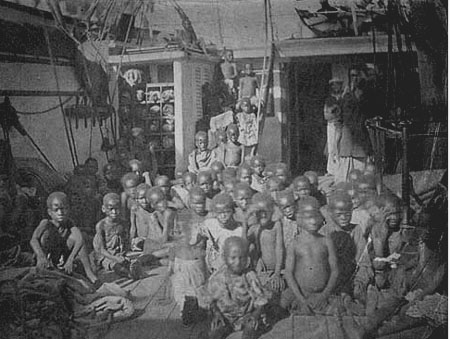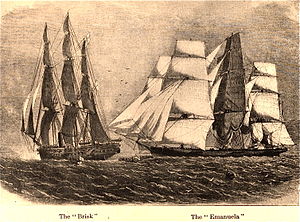
Thirty-nine years before the Amistad episode, the Ganges saga unfolded, one of the earliest slave trade violation cases confronted by the new republic. The Ganges case is a remarkable one because it reveals not only the sectional differences over slavery in the new republic but also the workings of the early federal system in Philadelphia when confronted with the issue of slavery and the slave trade. The precious archives related to this event also provide important details about enslaved Africans and early abolitionists in Pennsylvania.

The Ganges story began in 1800 when the U.S. Navy sloop Ganges captured two American slave schooners, Phoebe and Prudent, off the coast of Cuba with 134 African survivors on board. The vessels were brought back to Philadelphia for adjudication in federal court by Judge Richard Peters for violation of the 1794 Slave Trade Act. This early and littlediscussed federal law, passed by Congress while in Philadelphia, prohibited American vessels from participating in the slave trade. Judge Peters, who was sympathetic to the abolitionist cause, placed the Africans under the supervision and care of the Pennsylvania Abolition Society (PAS). The Africans were give the surname Ganges, indentured throughout the Greater Philadelphia region, and later became free. These indentures, among the PAS Papers at The Historical Society of Pennsylvania, give us a closer look at the enslaved Africans' stories.

Although the Ganges indenture records are by no means comprehensive and do not contain the same information for each person, they do provide clues about the Africans and the terms of their servitude. The population was largely young, aged 5 to 17. Females made up more than one-third of the group. Indentures extended until females reached 18 and males 21 years of age, with a minimum term of four years. Each indenture included a provision that the Africans obtain some level of education as well as learn a skill. In all cases Ganges Africans were to receive two full suits of clothing, one new, at the end of their indenture. Some were also to receive a modest sum of money, ranging from 15 to 25 dollars. Children were to be provided the most education, frequently for three-quarters of the day. The abolition society placed most of the Africans in groups, either within the same household or in a community with other Ganges. Most were indenture to Quakers in Bucks, Chester, and Delaware counties as well as the more rural parts of Philadelphia County, where males were to learn farming and milling and females "the mystery of housewifery." Only a few were apprenticed to learn other occupations: nail maker, mariner, and one to train to become the janitor at the Free School.

Currently we know only fragments about the lives of Ganges Africans in Pennsylvania. Nothing definitively indicates that any of them knew what was to happen to their lives or that they wanted to stay in America. Ganges 21 and over did assent to the arrangements made by the PAS by making marks on their indentures. However, Phyllis (Phillis) Ganges (Burr) believed throughout her life that she was "sold into slavery to pay for passage." A few Africans were even given first names like "Sambo," reflecting racial stereotypes of the time. Notwithstanding, it is apparent that the PAS's intent was to use the indenture system to maintain kinship relations among the Ganges, as well as provide the Africans with both a community and the skills to make a life in Pennsylvania as free persons. And at least to some extent, the PAS was successful. After his indenture Pompey Ganges appears in the federal census in 1810 with six other nonwhites in his household. Beloved young David Ganges, following his untimely death from an unknown illness, was mourned at his funeral by six of his shipmates, his custodial family, and other friends.
To this day, Ganges descendents reside in Pennsylvania. (source: ushistory.org/laz/news/pl1105.htm)

Maria Ganges's indenture, 1800. PAS Papers. Maria Ganges, a nine-year-old survivor, was indentured to Daniel Thomas in Frankford and was to be provided "three quarters day schooling" as well as training in "housewifery." It is not clear what happened to Maria at the end of her indenture.

Write more, thats all I have to say. Literally,
ReplyDeleteit seems as though you relied on the video to make your point.
You obviously know what youre talking about, why waste your intelligence
on just posting videos to your weblog when you could be giving us something informative to read?
Look at my web page - premier